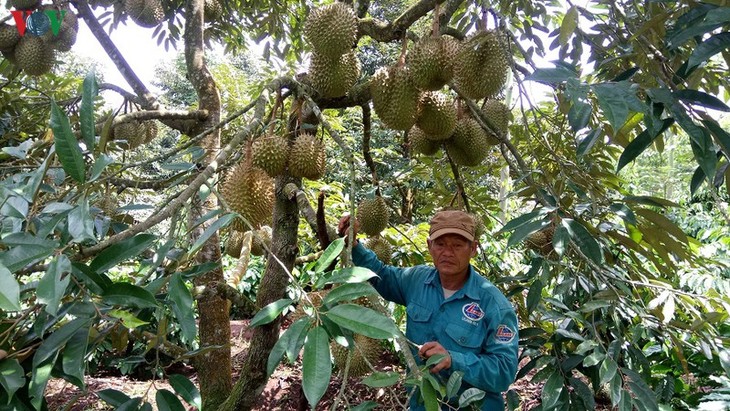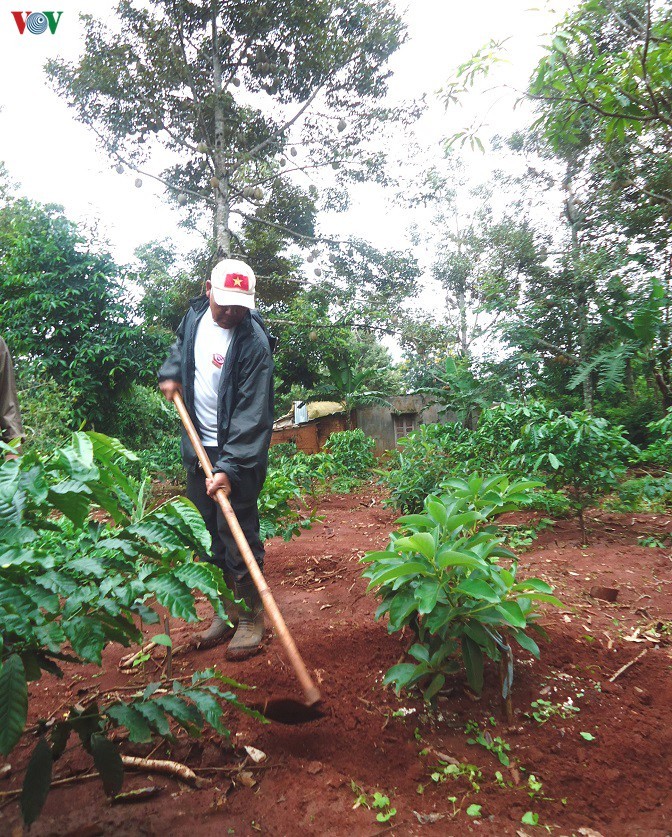(VOVWORLD) - In response to changing climate and markets, farmers in Dak Lak province have begun intercropping various types of plants in their coffee orchards. The tactic has boosted their income, provided windbreaks, and reduced the vulnerability of their coffee trees to drought and other weather extremes.
 Farmer Mai Dinh Phuong is by a durian tree in his coffee orchard Farmer Mai Dinh Phuong is by a durian tree in his coffee orchard |
Mai Dinh Phuong of An Phu hamlet in Dak Lak’s Cu Mgar district has been growing coffee trees for nearly 30 years.
In recent years, due to falling prices and the dwindling productivity of his old coffee plantation, Phuong has switched part of his land over to other kinds of fruit trees.
He said this intercropping has increased his income and kept his coffee productivity stable at an output of around 3 tons per hectare.
“Since we began intercropping our coffee trees with pepper, avocado, and durian trees, our yield has improved. Coffee monoculture results in lower efficiency and profits,” Phuong said.
Intercropping fruit trees in coffee orchards has helped Duong Van Thao of E Cham hamlet, Krong Ana district, prosper even when the price of coffee drops. He earns more than 17,000 USD a year from selling his durian and avocado.
“Coffee and pepper prices in the Central Highlands have fallen in recent years, so I have switched part of my 4 hectares of coffee trees to intercropped fruit and pepper trees. My income is now more stable,” Thao said.
|
 Intercropping in coffee orchards is a popular technical solution in the Central Highlands towards sustainable production and climate change response. Intercropping in coffee orchards is a popular technical solution in the Central Highlands towards sustainable production and climate change response.
|
The intercropped plants are mainly durian, avocado, pepper, macadamia, and kassod trees, which provide windbreaks for the coffee plantations.
Statistics from Dak Lak Agriculture and Rural Development Department indicate that one fifth of the province’s 200,000 hectares of coffee trees are in Cu Mgar and Krong Pak district, Buon Ho town, and Buon Ma Thuot city.
Dr. Phạm Cong Tri of the Central Highlands Agriculture and Forestry Science Institute says intercropping is very popular there among farmers who are very focused on mitigating climate change.
He added: “Once the model is widely adopted, we will see more sustainable specialized growing areas. All products sold will comply with Vietnam’s good agricultural practices and organic standards. We are combining farming and forest cultivation into an ecosystem in which coffee trees, grass cover, and multiple kinds of other plants are balanced.”